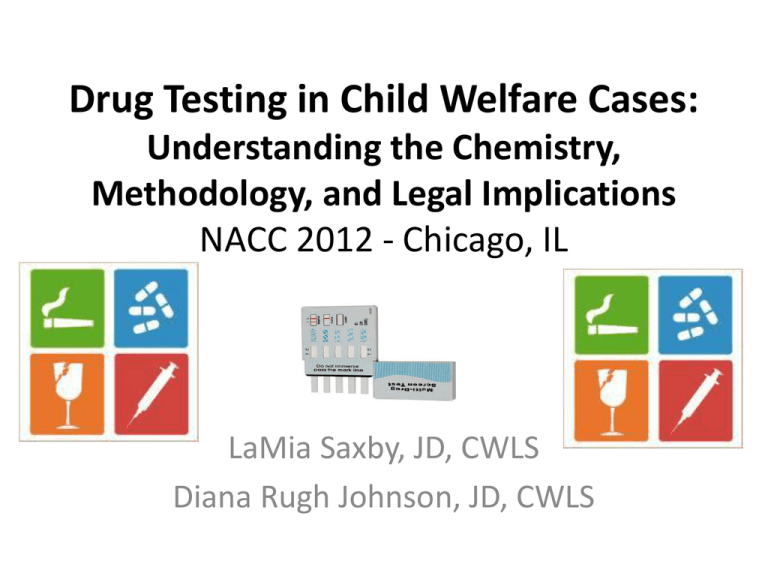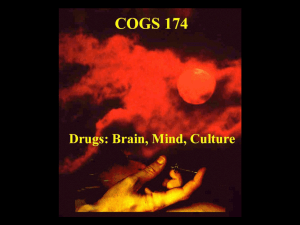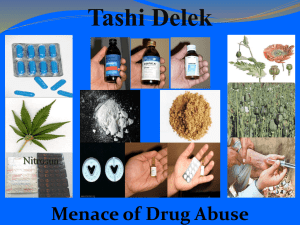Understanding Drug Tests Georgia Youth Law Conference
advertisement

Drug Testing in Child Welfare Cases: Understanding the Chemistry, Methodology, and Legal Implications NACC 2012 - Chicago, IL LaMia Saxby, JD, CWLS Diana Rugh Johnson, JD, CWLS Information is only useful when it can be understood. Commonly Abused Drugs Classified as Controlled Substances CONTROLLED SUBSTANCE CATEGORY DRUG Schedule I Heroin Marijuana LSD Peyote Schedule II Cocaine Methadone Oxycodone Codeine Amphetamine Methamphetamine Schedule III Testosterone Other anabolic steroids Schedule IV Benzodiazepines DRUGS AND THEIR METABOLITES • Most drugs are metabolized in the liver • Drug molecule is broken down and/or transformed into smaller molecules called metabolites HEROIN COCAINE OXYCODONE MARIJUANA URINE DRUG SCREENS POINT OF CARE TESTS • Lateral flow immunochromatographic assays • Drug metabolites are recognized and bound by specific antibodies • Chemical reaction color change SCHEMATIC OF THE POINT OF CARE URINE TEST ·The conjugate pad is coated with colored, colloidal gold nanoparticles conjugated with antibodies Structure of Antibodies ·The test line is affixed with drug conjugates, which are structurally similar to the portions of the drug metabolites that the antibodies will recognize. ·Urine sample tested contains no drug metabolites. ·The antibodies from the conjugate pad are carried along the test strip. The antibodies recognize and bind the drug conjugates on the test line. The line changes color. The control line changes color when the sample reaches it. ·Urine sample tested contains drug metabolites ·The antibodies on the conjugate pad recognize and bind the drug metabolites in the sample. There are no antibodies free to bind the drug conjugates on the test line. No color change at test line. LIMITATIONS OF IMMUNOCHROMATOGRAPHIC ASSAYS • • • • Concentration cutoffs Relatively short detection window Qualitative, not quantitative Antibody cross-reactivity with over-thecounter medications Typical Windows of Detection DRUG DETECTION WINDOW IN URINE Amphetamine 2 days Methamphetamine 2 days Cocaine 2 days after single use 4 days after repeated use Morphine 2-3 days Methadone 3 days Oxycodone 2-4 days Codeine 2 days Heroin 2 days Phencyclidine 14 days Marijuana 2-3 days after single use 30 days in chronic abuser Typical Cutoff Concentrations • Nanograms of metabolite per milliliter of urine DRUG CUTOFF CONCENTRATION Amphetamine 1000 ng/mL Benzodiazepines 200 or 300 ng/mL Barbiturates 200 or 300 ng/mL Cocaine 300 ng/mL Opiates 300 ng/mL Oxycodone 100 or 300 ng/mL Methadone 300 ng/mL Marijuana 50 ng/mL Phencyclidine 25 ng/mL Cutoff Concentrations 350 300 250 200 Positive test 150 Negative test 100 50 0 Benzodiazepines Cocaine Marijuana Multiple positive drug tests from a single use Concentration ng/mL 120 Concentration cutoff for point of care test 100 Point of Care test 80 60 GC/MS test 40 Drug/EtOH evaluation 20 0 1 2 3 4 5 6 7 Day 8 9 10 11 12 Products that Interfere with Amphetamine/Methamphetamine Screening Immunoassays CLASS OF DRUG INTERFERING COMPOUND SOME PRODUCT NAME(S) Antihistamine Brompheniramine Allent, Andehist syrup, Bromadrine PD, BromofedDMDallergy, Demetapp Diet Pill Ephedra (ephedrine) Phentermine Tyramine Decongestant Phenylpropanolamine Pseudoephedrine Phenylephrine Acid reducer Ranitidine Actifed, Alka-Seltzer Plus, Allegra-D, Clartin D, Comtrex Daytime, Tylenol, Tylenol Sinus, Vicks 44 Zantac URINE DRUG SCREENS GC/MS TESTS • Gas chromatography/mass spectrometry • Molecules (including drug metabolites) in purified sample are separated from each other in the GC column • As each molecule leaves the GC column, it is bombarded with electrons, which break the molecule into fragments • The fragments are detected and analyzed by the mass spectrometer • A drug metabolite’s fragmentation pattern is like a fingerprint for that drug GC/MS instrument Inner workings of the GC/MS Mass spectrometry distinguishes between similar compounds HAIR FOLLICLE TESTING • Hair is composed of mostly protein • Principle protein = keratin • Drug metabolites in bloodstream are deposited in hair follicle • Metabolites get trapped in keratin matrix of hair as it grows Effect of Growth Rate • Growth rate = 0.7 – 1.5cm/month • Average growth rate = 1cm/month • 3cm hair specimen represents ~3 month period • Standard sample collection = 3.75cm • Lag times: abuse incorporation of metabolites into follicle incorporation into keratin matrix growth of hair above surface of skin Test Results vs. Actual Use T P R ? Incarceration U 90 days 90 days July 30, 2010 July 20, 2010 July 10, 2010 June 30, 2010 June 20, 2010 June 10, 2010 May 31, 2010 May 21, 2010 May 11, 2010 May 1, 2010 April 21, 2010 April 11, 2010 April 1, 2010 March 22, 2010 March 12, 2010 March 2, 2010 February 20, 2010 February 10, 2010 January 31, 2010 January 21, 2010 January 11, 2010 January 1, 2010 December 22, 2009 Effect of Hair Color • Melanin is responsible for hair color • Melanin is a polymer consisting of eumelanin (black/brown) and phemelanin (red) • Drug metabolites bind more to eumelanin than to pheomelanin • Racial difference: after the same dosage pattern of codeine, Asians with black hair tested 56% higher than Caucasians with black hair. Asians have a higher percentage of melanin in their hair. LEGAL EFFECTS OF SUBSTANCE ABUSE ON REUNIFICATION LAMIA N. SAXBY, Esq., CWLS Special Assistant Attorney General Fulton County, Atlanta, Georgia Findings in deprivation proceedings. (a) Findings. After hearing the evidence on any petition alleging deprivation, the court shall make and file its findings as to whether the child is a deprived child. If the court finds that the child is not a deprived child, it shall dismiss the petition and order the child discharged from any detention or other restriction theretofore ordered in the proceeding. (b) Findings with regard to result of alcohol abuse or drug abuse. If the court finds that a child is deprived, the court shall also make and file a finding as to whether such deprivation is the result of alcohol abuse or drug abuse by a parent or guardian. (c) Disposition. The court shall proceed immediately or at a postponed hearing to make a proper disposition of the case in accordance with Code Section 15-11-55 if the court finds from clear and convincing evidence that the child is deprived. Assessment in Cases with Substance Abuse Allegations • Safety/Risk Assessment – Is child deprived? • If No, are there services needed that will assist the mother/father/guardian with better meeting the needs of the child. – – – – Parenting classes Parent aid Family counseling Individual counseling » For parent » For child Basis for deprivation CAUSES: • Inadequate supervision • Inadequate parental care – Neglect of child » physical, mental, emotional health – Abandonment – Abuse » Physical (visible marks/outcry/mandated reporter) » Emotional (verbal abuse, targeting 1 child) » Sexual (medical neglect, failure to protect) • Inadequate housing – Not poverty concerns but housing conditions » Deplorable conditions » Latent safety risks (rodents, health code violations) Does Parental Substance Abuse Affect the Child? • Do not focus on Parental Fault • Focus Assessment on needs of child – Is the child clearly at risk of harm if she is allowed to remain in the caregiver’s custody • Does mom feed her baby inappropriate food even after being advised by the parenting specialist about risks of inappropriate food choices – Choking hazards, digestion issues, failure to thrive What is Parent’s Drug of Choice? • Marijuana – Must show adverse effects on child • Cocaine (Crack) – Extensive history used to establish that conditions of deprivation are likely to continue • Methamphetamines – COA took judicial notice of the children exposed to methamphetamines are at an increased risk of victimization because the drug increases paranoia and rage Affects of parental substance abuse on Children • An extensive history of substance abuse problems and/or a current extended period of unrehabilitated substance abuse show an unresolved pattern of behaviors that increase the likelihood that the conditions of deprivation that brought the child into care are likely to continue. Substance abusing parent CAN maintain custody Where no evidence was presented that the mother's drug use had an adverse effect on the children, and there is no evidence to show the mother was such a chronic abuser of alcohol or drugs that such an effect can be inferred here, the child is Usually allowed to remain in the custody of the parent. MARIJUANA, ALCOHOL, PRESCRIPTION DRUGS Although we do not condone the mother's abuse of prescription drugs or the father's use of marijuana, the evidence does not clearly and convincingly establish that M. L. C. is deprived. Rather, it is uncontroverted that the parents, despite their problems, have taken care of M. L. C. Evidence showing that M. L. C. is a good student and a well-adjusted child who recognizes the pitfalls of drug use attests to the fact that her basic physical, mental, and emotional needs have been met. IN RE MLC 249 Ga. App. 435 (2001) METHAMPHETAMINE ABUSE The juvenile court was entitled to infer from the mother's continued use of methamphetamine that the mother was suffering from a chronic substance abuse problem that she could not easily control or overcome &deprivation likely to continue. RECENT COURT CASES Substance Abuse and the Effects on Reunification Court Can Require Parent To Remain Drug Free • If deprivation is found to have been the result of alcohol or other drug abuse by a parent or guardian, . . . the court is authorized to further order that legal custody of the child may not be transferred back to the child's custodian or guardian whose abuse of alcohol or another drug resulted in the child's deprivation unless such person undergoes substance abuse treatment and random substance abuse screenings and those screenings remain negative for a period of no less than six consecutive months. • Therefore, it was within the juvenile court's discretion to require that the mother successfully complete all components of her substance abuse treatment, including the aftercare rehabilitation program, while remaining drug free, before reconsidering its deprivation order awarding temporary custody of the child to the maternal grandmother TERMINATION OF PARENTAL RIGHTS AFTER COMPLETION OF TREATMENT • The child was placed in the Department’s custody after the mother failed to test negative for illegal drugs for six months, failed to provide adequate housing and employment and neglected the child’s medical and dental needs. • The mother successfully completed the residential portion of her drug treatment program BUT refused to complete the aftercare portion, a requirement of her reunification case plan. TERMINATION AFTER FAILURE TO REMAIN SOBER AND TO COMPLETE CASE PLAN • The father did not fulfill the goals of his reunification case plan when he continued to abuse alcohol, failed to pay support, and was repeatedly incarcerated. • Here, the Court properly determined that the termination of parental rights was supported by clear and convincing evidence. RECENT IMPROVEMENTS • The Court of Appeals held that although the mother had made some efforts to improve, the COA held that recent improvements do not establish that the parent is capable of maintaining the progress.” Excessive History of Drug Abuse • Mother gave birth to child 6 wks premature. Child was diagnosed with “cocaine addiction affecting the fetus/newborn via the placenta and breast milk.” • In addition to the mother testing positive for drugs at the birth of NH, the mother tested positive for cocaine and marijuana 18 days after birth of child. Mom admitted to being addicted to crack cocaine for 5 years and to smoking crack & marijuana during her pregnancy INFERENCE OF DEPRIVATION In determining whether a child is without proper parental care or control, a juvenile court can consider the parent’s excessive use of or a history of chronic, unrehabilitated abuse of controlled substances. From the chronic drug use, a court can also infer an adverse impact on the child and find the child deprived. INFERENCE OF DEPRIVATION • Despite the mother’s claim at the hearing that she had stopped using drugs because of her baby, the court is entitled to, reject her testimony when compared to the other evidence in the case, and find the child deprived based upon the mother’s chronic use of illegal drugs. In the interest of N.H., 297 Ga App 344 (2009) Deprivation Likely to Continue • Mother and newborn test positive for cocaine at delivery. Ch was found deprived because of mom’s substance abuse & Dept history • For 2 yrs mom failed to comply with reunification goals to complete drug treatment, maintain housing& employment & complete parenting classes. • COA: court did not err in finding cause of deprivation likely to cont. – In the Interest of S.H., 296 Ga App 768 (2009) LACK OF FINANCIAL SUPPORT • The COA emphasized the fact that the parents’ status as substance abusers rendered them unable to provide for the child financially, rather than the mere fact that both of the child’s parents were substance abusers. • Focus is on needs of the child rather than on parental fault. – In re C.N.G. 204 GA App 239 (1992) REVIEW OF LEGAL CONSIDERATIONS 1. Courts MUST make specific findings as to alcohol/drug abuse in deprivation orders 2. Safety/Risk assessment made in cases with substance abuse allegations 3. Basis for deprivation: 1. Inadequate housing, supervision 2. Abuse, Neglect 4. Inference of Deprivation? 5. Deprivation likely to continue? REMEMBER, FOCUS ON NEEDS OF CHILDREN & NOT ON PARENTAL FAULT! Thank You & Good Day! LAMIA N. SAXBY, Esq., CWLS Special Assistant Attorney General Fulton County, Atlanta, Georgia








